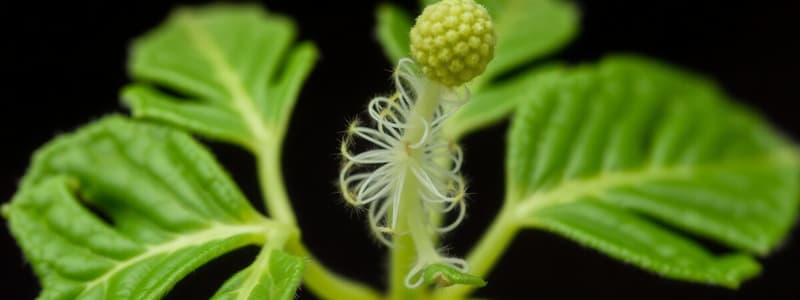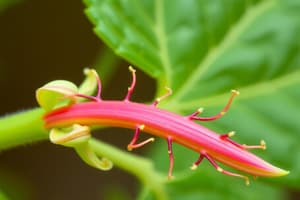Podcast
Questions and Answers
Which structural adaptation primarily facilitates survival for nonvascular plants in moisture-rich environments?
Which structural adaptation primarily facilitates survival for nonvascular plants in moisture-rich environments?
- Reliance on rhizoids for anchorage and surface water absorption. (correct)
- Development of a complex root system for deep water absorption.
- Evolution of specialized vascular tissues for efficient water transport.
- Presence of a waxy cuticle to minimize water loss through transpiration.
In vascular plants, what evolutionary advantage does the development of the shoot system provide in terrestrial environments?
In vascular plants, what evolutionary advantage does the development of the shoot system provide in terrestrial environments?
- Optimized light interception for photosynthesis and elevated reproductive structures for dispersal. (correct)
- Enhanced nutrient absorption from direct soil contact.
- Increased efficiency in water conservation through specialized epidermal cells.
- Improved structural support allowing plants to withstand strong winds.
How does the arrangement of vascular bundles differentiate monocots from dicots, influencing their structural integrity and adaptability to environmental stress?
How does the arrangement of vascular bundles differentiate monocots from dicots, influencing their structural integrity and adaptability to environmental stress?
- Monocots have scattered vascular bundles that offer resilience against bending forces, unlike the ringed arrangement in dicots, which is more susceptible to breakage. (correct)
- Monocots have vascular bundles with cambium allowing secondary growth, different from dicots.
- Monocots have vascular bundles arranged in a ring, providing greater flexibility under stress, whereas dicots have scattered bundles for enhanced rigidity.
- Dicots and monocots both have circular arrangements, just with different ratios of xylem to phloem elements.
What critical role do stomata play in the adaptation of plants to varying environmental conditions?
What critical role do stomata play in the adaptation of plants to varying environmental conditions?
How do the reproductive strategies used in nonvascular plants differ significantly from those in seedless vascular plants, impacting their respective ecological niches?
How do the reproductive strategies used in nonvascular plants differ significantly from those in seedless vascular plants, impacting their respective ecological niches?
In the context of plant reproduction, what evolutionary advantage do pollen grains offer to seed-producing plants compared to spore-dependent plants?
In the context of plant reproduction, what evolutionary advantage do pollen grains offer to seed-producing plants compared to spore-dependent plants?
How does the process of meiosis contribute to the genetic diversity within plant populations?
How does the process of meiosis contribute to the genetic diversity within plant populations?
What adaptive significance does the cuticle provide to plants in varying terrestrial environments?
What adaptive significance does the cuticle provide to plants in varying terrestrial environments?
How does the evolutionary transition from dominant gametophyte to dominant sporophyte generation reflect adaptations to terrestrial environments?
How does the evolutionary transition from dominant gametophyte to dominant sporophyte generation reflect adaptations to terrestrial environments?
How does xylem contribute to the overall fitness of vascular plants in competing for resources in diverse ecosystems?
How does xylem contribute to the overall fitness of vascular plants in competing for resources in diverse ecosystems?
In the evolutionary transition from aquatic algae to terrestrial plants, which adaptation presented the greatest initial challenge regarding reproduction?
In the evolutionary transition from aquatic algae to terrestrial plants, which adaptation presented the greatest initial challenge regarding reproduction?
Consider a plant species exhibiting a novel mutation that disables the production of abscisic acid (ABA). Under which environmental condition would this mutation most likely prove detrimental to the plant's survival?
Consider a plant species exhibiting a novel mutation that disables the production of abscisic acid (ABA). Under which environmental condition would this mutation most likely prove detrimental to the plant's survival?
A researcher is studying a newly discovered plant species in a tropical rainforest. The plant exhibits rapid vertical growth, utilizing surrounding vegetation for support. Which combination of adaptations would most likely be observed in this plant?
A researcher is studying a newly discovered plant species in a tropical rainforest. The plant exhibits rapid vertical growth, utilizing surrounding vegetation for support. Which combination of adaptations would most likely be observed in this plant?
In comparing gymnosperms and angiosperms, which of the following evolutionary advancements in angiosperms provides the most significant advantage in terms of reproductive success and diversification?
In comparing gymnosperms and angiosperms, which of the following evolutionary advancements in angiosperms provides the most significant advantage in terms of reproductive success and diversification?
Consider a scenario where a plant population is subjected to a sudden and drastic reduction in pollinator diversity. Which of the following plant reproductive strategies would likely exhibit the greatest resilience in response to this environmental change?
Consider a scenario where a plant population is subjected to a sudden and drastic reduction in pollinator diversity. Which of the following plant reproductive strategies would likely exhibit the greatest resilience in response to this environmental change?
A plant physiologist is investigating the effects of a novel chemical compound on plant growth. Treatment with the compound results in significantly increased stem elongation and premature seed germination. Which plant hormone is the compound most likely mimicking or enhancing the effect of?
A plant physiologist is investigating the effects of a novel chemical compound on plant growth. Treatment with the compound results in significantly increased stem elongation and premature seed germination. Which plant hormone is the compound most likely mimicking or enhancing the effect of?
In a plant exhibiting strong apical dominance, what would be the expected outcome of experimentally removing the apical bud?
In a plant exhibiting strong apical dominance, what would be the expected outcome of experimentally removing the apical bud?
Consider a plant species adapted to saline (salty) environments. Which of the following adaptations would be LEAST likely to be observed in this plant?
Consider a plant species adapted to saline (salty) environments. Which of the following adaptations would be LEAST likely to be observed in this plant?
Which of the following represents the correct sequence of evolutionary appearance of plant groups, from earliest to most recent?
Which of the following represents the correct sequence of evolutionary appearance of plant groups, from earliest to most recent?
A researcher discovers a mutant plant that exhibits constitutive phototropism, bending towards light even in the absence of a directional light source. Which of the following is the most likely cause of this phenotype?
A researcher discovers a mutant plant that exhibits constitutive phototropism, bending towards light even in the absence of a directional light source. Which of the following is the most likely cause of this phenotype?
Flashcards
Nonvascular Plants
Nonvascular Plants
Plants lacking specialized tissues for water and nutrient transport
Vascular Plants
Vascular Plants
Plants with xylem and phloem for water and nutrient transport.
Shoot System
Shoot System
Plant organ system for photosynthesis, reproduction, and support.
Root System
Root System
Signup and view all the flashcards
Dermal Tissue
Dermal Tissue
Signup and view all the flashcards
Vascular Tissue
Vascular Tissue
Signup and view all the flashcards
Gymnosperms
Gymnosperms
Signup and view all the flashcards
Angiosperms
Angiosperms
Signup and view all the flashcards
Alternation of Generations
Alternation of Generations
Signup and view all the flashcards
Mitosis
Mitosis
Signup and view all the flashcards
Purpose of a Seed
Purpose of a Seed
Signup and view all the flashcards
Pollination
Pollination
Signup and view all the flashcards
Seed Dispersal
Seed Dispersal
Signup and view all the flashcards
Cuticle
Cuticle
Signup and view all the flashcards
Stomata
Stomata
Signup and view all the flashcards
Auxins
Auxins
Signup and view all the flashcards
Gibberellins
Gibberellins
Signup and view all the flashcards
Abscisic Acid
Abscisic Acid
Signup and view all the flashcards
Study Notes
- Plants are unique in their structure, reproduction, and adaptations
- How plants are structured, how they reproduce, and how they adapt to the environment is key to plant survival
Plant Structure
- A flow chart or diagram can visually represent the structural diversity among plants
- Plants can be divided into nonvascular and vascular types
Nonvascular Plants
- Nonvascular plants (bryophytes) lack specialized tissue for water and nutrient transport
- They include liverworts, mosses, and hornworts that differ in habitat and reproduction
Vascular Plants
- Have xylem and phloem for water and nutrient transport
- Contain shoot systems (stems, leaves, flowers) and root systems (roots)
- Shoots are responsible for photosynthesis, reproduction, and support
- Roots anchor plants and absorb water and minerals
Plant Tissues
- Vascular plants have three tissue types
- Dermal tissue offers protection via cuticle and stomata
- Vascular tissue transports water (xylem) and nutrients (phloem)
- Ground tissue offers storage and support via parenchyma, collenchyma, and sclerenchyma
Plant Types
- Vascular plants can be divided into seedless (ferns) and seed-producing (gymnosperms and angiosperms)
- Gymnosperms bear cones, while angiosperms bear flowers and fruits
Flower Structure
- Flowers include sepals, petals, pistil (stigma, style, ovary), stamen (anther, filament), ovule, and fruit
Monocots vs Dicots
- Monocots feature one cotyledon, parallel veins, scattered vascular bundles, and fibrous roots
- Dicots feature two cotyledons, net-like veins, ringed vascular bundles, and taproots
Plant Reproduction
- Plant lifecycles feature alternation of generations
- Lifecycles alternate between a haploid gametophyte and a diploid sporophyte stage
Mitosis vs Meiosis
- Mitosis is for growth and asexual reproduction, producing identical cells
- Meiosis produces gametes/spores for genetic diversity
Nonvascular vs Seedless Reproduction
- Both rely on spores and require water for fertilization
- Nonvascular have a dominant gametophyte stage
- Seedless vascular have a dominant sporophyte stage
Gymnosperm vs Angiosperm Reproduction
- Gymnosperms use cones, wind pollination, and exposed seeds
- Angiosperms use flowering with diverse pollination methods for enclosed seeds in fruits
Seed Purpose
- Seeds protect the embryo, store nutrients, and aid in dispersal
Pollination Strategies
- Pollination methods include wind, insects, and animals
Seed Dispersal Methods
- Seeds can disperse via wind, water, and animals
Plant Evolution
- Plant evolution started with aquatic ancestors, then nonvascular, then seedless vascular, then gymnosperms, then angiosperms
Adaptations for Terrestrial Life
- Adaptations include a cuticle to prevent water loss and stomata for gas exchange
- Roots and vascular tissue transport water and nutrients
- Seeds and pollen enable reproduction without water
Plant Response
- Plants use signal transduction pathways to detect and react to stimuli, for example, light, gravity, or touch
Plant Hormones
- Auxins: Cell elongation and phototropism
- Cytokinins: Cell division
- Gibberellins: Seed germination
- Ethylene: Fruit ripening
- Abscisic acid: Growth inhibition and drought response
Environmental Adaptations:
- Desert plants use succulence, deep roots, and CAM photosynthesis
- Aquatic plants feature aerenchyma, floating leaves
- Climbing plants have tendrils for thigmotropism
Studying That Suits You
Use AI to generate personalized quizzes and flashcards to suit your learning preferences.
Related Documents
Description
Explore the unique structures, reproductive strategies, and adaptations of plants. Distinguish between nonvascular plants (bryophytes) and vascular plants with xylem and phloem. Learn about shoot systems for photosynthesis and root systems for water absorption and anchorage.




